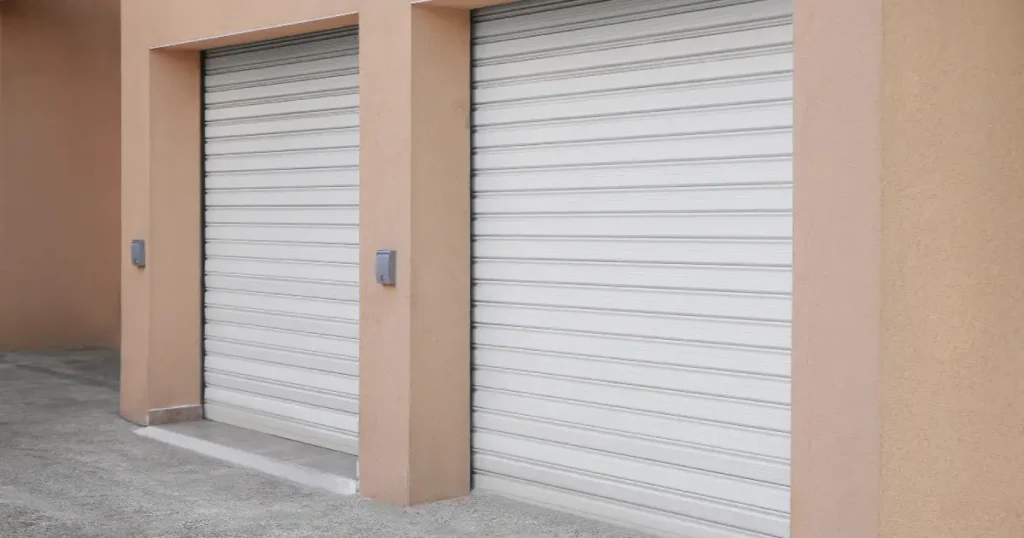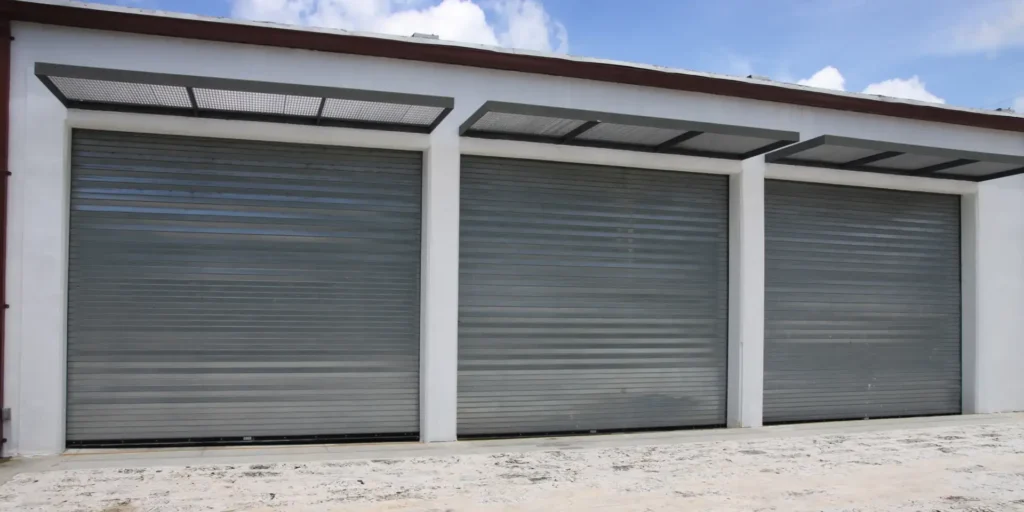To maintain performance, safety and longevity, regular maintenance is required for roller shutter doors. Whether located at a home, retail store, or industrial unit, shutters face daily wear and tear as well as exposure to the elements. This guide describes how to clean, inspect and maintain them in a streamlined fashion— detailing steps for DIY and Facility Managers.
For a broader understanding of shutter systems, see our complete roller shutters guide, which explains their types, uses, and core components.
Understanding the Necessity of Roller Shutter Door Maintenance

Roller shutters form an integral part of security infrastructure. If insufficient attention is allocated toward them, they may become noisy or suffer from unexpected failure. Proper attention placed alongside proactive measures extends lifespan while preventing breakdowns.
Tracks and rollers often accumulate dust alongside other forms of stubborn debris which lead to friction exacerbating strain on motors as well as corrosion overtime. Maintenance not only eliminates debris but also uncovers early signs of damage guaranteeing seamless operation post maintenance.
From the business perspective, malfunctioning shutters equal considerable downtime or usher potential security risks while homeowners are stripped off convenience and peace-of-mind- both greatly valued luxuries. Regular upkeep also ensures adherence to manufacturer guidelines through warranty validation.
Upkeep goes beyond just cleaning; actuated shutters that run quietly translates to enhanced safety alongside improved energy efficiency leading to greater productivity overall. For residential, commercial, and industrial needs IDL Windows offers roller shutter doors. While their products are manufactured with durability in mind, they still require maintenance to remain in good condition and perform at their best.
Tools and Products You’ll Need
The following items are necessary to maintain a roller shutter door:
- Mild detergent and water.
- Soft cloth or microfiber towel.
- A vacuum or compressed air (for debris).
- Silicone-based or lithium grease spray.
- A ladder (if manual inspection is required).
- Screwdrivers or a wrench (for small adjustments).
- Personal protective equipment (gloves, glasses).
Harsh chemicals and pressure washers must be avoided as they can damage paint coatings, sealed components, windows, or weather strips.
Lubricants used should not contain oils and should be free of residues. Automatic shutters should also avoid petroleum based lubricants as these attract dust thus leading to dirty sensors and impaired functioning.
For shutters installed by IDL, refer to the maintenance manual for suggestions on approved external care items such as cleaners and parts.
Step-by-Step Guide to Maintaining Roller Shutters
1. Visual Inspection
Examine the surface of the Shutter looking for scratches that might need buffing out; visually inspect from top to bottom checking for any obstructions along the edge like dirt residue build up.
Look for the following issues:
- As previously noted, slats can sustain fractures and dents.
- Parts that are cables or more specialized like bolts may display signs of rusting or fraying.
- Brackets as well as any guides might sometimes come loose.
- It is possible for panels and tracks to experience gaps in their placement relative to each other due to misalignment.
For homes, seasonal visual checks are sufficient, while high-traffic commercial or industrial shutters should be inspected bi-monthly. Learn more about what affects each type by exploring the different types of roller shutters.
IDL windows recommends visual inspections every two months for high-traffic areas, while seasonal checks are better suited for residential doors.
2. Cleaning Surface And Tracks
Use a soft cloth immersed in warm water to wipe the shutter curtain clean; joints and slats tend to collect dust and require special attention.
Dirt collects in guide rails which can cause alignment issues and produce unwanted noise.
For powered shutters (and all types of shutters), never spray water into the motor housing; ensure power is isolated prior to cleaning.
Metal shutters must have all parts dried after cleaning because exposure leads to rust forming, even if they’re coated systems that resist moisture. While IDL recommends drying them usually in low-humidity conditions improves their longevity regardless by offsetting dangers associated with trapped moisture within stubborn recesses.
3. Lubrication Of Parts That Are In Motion
Bearing spacers along with tuners will benefit from lubrication too, making motion less dusty when applied lightly.
Use silicone-based sprays because they operate best on hinges sprigs pivot points slackened along gully cams however maintenance commands putaways gentle touches due attract deceitful attention pesky dirt grime accumulation
Alongside guiding tracks mentioned earlier hinges suffer from sluggish motion hence gains provided infractions mark achievement delieclaim acknowledgement help depression as equilibrium restored system unifies throughout semblances spring tensioner arms
Following lubrication, manual shutters ought to slide up and down with minimal resistance. For electric systems, listen for smoother and quieter movement when actuating the system.
IDL Windows recommends lubricating every 4-6 months based on usage. Always avoid over application of lubricant especially on motors or sensors. For insights into the structural benefits of using heavy-duty materials, see our post on the benefits of steel roller shutters.
If you’re planning to upgrade or install new units, IDL Windows offers professional shutter doors supply and fit services tailored to homes, retail spaces, and industrial buildings. Our robust steel shutters are built for longevity and supported by expert installation and aftercare.
4. Testing the Operation Mechanism
Open and close the shutter fully.
Look for:
- Hesitation or jerky motion
- Uneven rolling/off track movement
- Delays in motorized responsiveness
Additionally, listen for squeaks, groans, or any other abnormal noises. Test the backup manual release on electric shutters to ensure functionality during power outages.
Shutters supplied by IDL come with integrated safety stops—test these too by gently blocking the bottom bar during closure. It should either halt or reverse automatically.
5. Inspection for Damage or Wear
Examine:
- Rubber seals for tearing/hardening
- Paint finishes for peeling or rust
- Cable wear and cracks in belts on motor driven units
Even minor indications of damage can cause significant issues if not promptly addressed. Document evidence of wear such as notes or pictures, especially in high traffic commercial areas.
For part replacements you are uncertain about, contact IDL Windows as they provide inspection and repair services.
Maintenance Recommendations by Category

Residential Roller Shutters
These types of shutters are mainly used on windows and garages, thus being exposed to seasonal temperature fluctuations. They withstand wear due to infrequent usage.
Recommendations:
- Remove dirt build up on tracks every 3-4 months
- Check manual wipe feature each season
- Apply lubricant semi annually
- Ensure shutter closing is gentle to avoid abrupt slamming
- Dust-free safety sensors are a must for proper functioning shutters safeguarding debris prevents inside electric shutters from IDL.
Commercial Shutter Doors
These shutters have increased usage for storefronts and service entrances compared to the rest of the commercial shutters, resulting in greater wear.
Recommendations:
- Monthly inspection should be conducted with strict adherence
- Lubricate non-drying friction surfaces like tracks and tensioners every three months
- Bottom slats must be locked firmly each night
- Should establish routine professional maintenance schedules annually
- IDL’s commercial doors come with impact-resistant coatings—maintain these clear of contaminants to avert diminishing transparency and prevent surface degradation.
Industrial Roller Doors
IDL shutters of this type are much heavier in weight then others and often automated.
Recommendations:
- Clear debris from sensors monthly alongside control guides within a window of 2-4 weeks
- Grease all portions subject to movement once a month
- Examine console sections of controls for damages
- Quarterly adjust limit stops and motor tensions for calibration tightness
- Log regular brake testing and maintenance facilitated at set intervals from compliance documentation requirements supporting employment aligned policy integrations tracked mandates.
When Maintenance Should Be Handled By A Professional Specialist

Setting your own intervals for maintenance tasks poses drawbacks.
Contact a skilled technician if you observe the following:
- Grinding or strained motors
- Shutter misalignment or jamming issues
- Complete malfunction of the system
- Electrical malfunctions alongside sensors not functioning correctly
- Tracks that are bent or structurally damaged
IDL Windows offers maintenance services on all varieties of roller shutters. Their trained professionals ensure adherence to legal obligations and safety protocols while restoring full functionality in a streamlined manner.
Ensure Efficiency While Minimizing Hurdles
The process can be simple; however, neglecting these actions will add hurdles along your path which can easily be avoided by embracing preventive measures through consistency.
Whether it is at home or within a commercial CID setting—steadfast upkeep will defend reliable performance in the long-term where help beyond DIY scope This sends out a call for expert servicing readiness from IDL Windows.
Avoid this umbrella term of shielding investments by routine oversight during set intervals that fortify operational reliability—smooth shutter motions—boost security with ease available thereafter assured effective steadfast preservation. Take action now—book a service with IDL Windows to ensure your roller shutters stay secure, smooth, and dependable for years to come.
